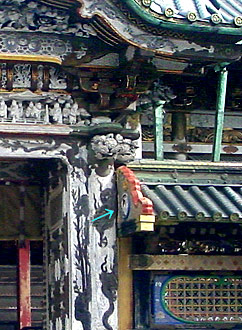|
||
 |
||
A board cut in a decorative shape and attached at a right angle to the projecting end of a purlin, the extended end of a horizontal beam used in fencing, or on both ends of a mud-roofed gate *agetsuchimon γyε. The support is called *eburidai ΏUδ and the indented curve on the upper part of the ornamental shape is called eburidani ΏUJ. A decorative board may also be attached to the overhanging end of a pent roof *hisashi ω. The term is commonly used for an ornamental board used to hide otherwise exposed edges on folk dwellings *minka ―Ζ. The name is derived from a farmer's tool eburi ΏU that was made of a square board with a long handle attached at right angle. It served the same purpose as the western hoe. Thus, attaching a board to the end of a beam recalled the hoe, and the name was transferred to a similar arrangement of members in architecture.
@

Nikkou
Toushouguu Karamon
ϊυΖ{ε (Tochigi)
ϊυΖ{ε (Tochigi)
@
(C)2001 Japanese Architecture and Art Net Users System.@No reproduction or republication without written permission.
fΪΜeLXgEΚ^ECXgΘΗASΔΜRecΜ³f‘»E]ΪπΦΆά·B

